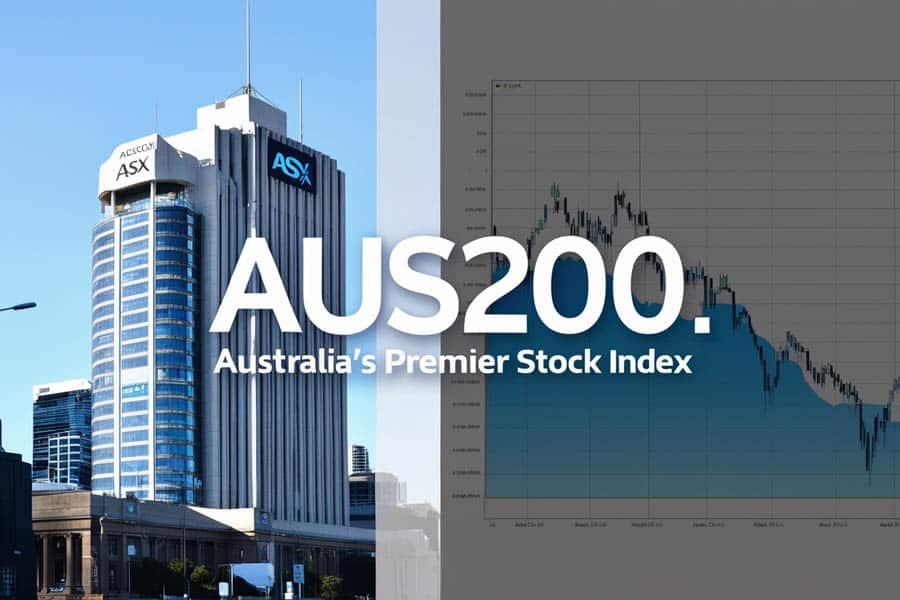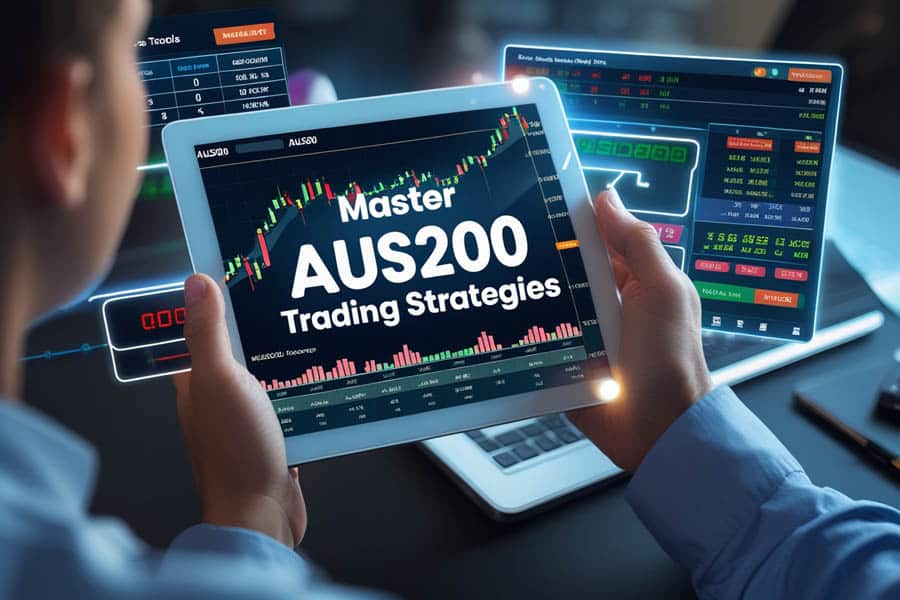Did you know that the AUS200, Australia’s premier stock market index, is one of the most traded indices in the forex market? Whether you’re a seasoned trader looking to diversify your portfolio or a beginner eager to explore new opportunities, understanding the AUS200 in forex can be a game-changer. The AUS200, also known as the S&P/ASX 200, represents the performance of the top 200 companies listed on the Australian Securities Exchange (ASX). In forex trading, it’s traded as a Contract for Difference (CFD), allowing traders to speculate on its price movements without owning the underlying assets.

But why should you care about the AUS200? For starters, it offers a unique window into the Australian economy, which is heavily influenced by commodity prices, global market trends, and domestic economic policies. Trading the AUS200 can provide diversification, leverage opportunities, and exposure to one of the most stable economies in the Asia-Pacific region.
In this comprehensive guide, we’ll dive deep into what the AUS200 is, how it works, and why it’s a popular choice among traders. We’ll also explore the factors that influence its price, how to trade it effectively, and the benefits and risks involved. Plus, we’ll introduce you to Opofinance, a trusted and regulated forex broker that can help you navigate the world of AUS200 trading with confidence.
Ready to unlock the potential of the AUS200? Let’s get started!
Understanding the AUS200

The AUS200, or S&P/ASX 200, is more than just a stock market index—it’s a reflection of Australia’s economic health and a key indicator of market sentiment. But what exactly is it, and how does it work? Let’s break it down.
What Is the AUS200 Index?

The AUS200 index is a market-capitalization-weighted index that tracks the performance of the 200 largest companies listed on the Australian Securities Exchange (ASX). It’s widely regarded as the benchmark for the Australian equity market and is used by investors and traders to gauge the overall health of the economy.
The index was launched in April 2000 by Standard & Poor’s (S&P) and has since become the most widely quoted benchmark for Australian equities. It covers approximately 80% of the Australian equity market by capitalization, making it a reliable indicator of the country’s economic performance.
Read More: Analysis of International Markets in Forex
Composition of the AUS200
The AUS200, or S&P/ASX 200, is a diversified index that represents the performance of the top 200 companies listed on the Australian Securities Exchange (ASX). Its composition is a reflection of Australia’s economic landscape, encompassing a wide range of sectors and industries. Understanding the composition of the AUS200 is crucial for traders and investors, as it provides insights into the factors driving the index’s movements.
Sector Breakdown
The AUS200 is divided into several key sectors, each contributing to the index’s overall performance. Here’s a detailed look at the major sectors and their significance:
- Financials:
The financial sector is the largest component of the AUS200, accounting for approximately 30% of the index. It includes major banks, insurance companies, and financial services providers. - Materials:
The materials sector is the second-largest component, making up around 20% of the AUS200. This sector includes companies involved in mining, metals, and chemicals. - Healthcare:
The healthcare sector accounts for approximately 10% of the AUS200. It includes companies involved in pharmaceuticals, biotechnology, and healthcare services. - Consumer Discretionary:
The consumer discretionary sector makes up around 8% of the AUS200. It includes companies involved in retail, travel, and leisure. - Industrials:
The industrials sector accounts for approximately 7% of the AUS200. It includes companies involved in transportation, construction, and engineering. - Information Technology:
The information technology sector makes up around 5% of the AUS200. It includes companies involved in software, hardware, and IT services. - Energy:
The energy sector accounts for approximately 4% of the AUS200. It includes companies involved in oil, gas, and renewable energy. - Utilities:
The utilities sector makes up around 3% of the AUS200. It includes companies involved in electricity, gas, and water supply. - Real Estate:
The real estate sector accounts for approximately 3% of the AUS200. It includes companies involved in property development, management, and investment. - Consumer Staples:
The consumer staples sector makes up around 2% of the AUS200. It includes companies involved in food, beverages, and household products.
Top Companies in the AUS200
The AUS200 is dominated by a few large companies that have a significant impact on the index’s performance. Here are some of the top companies and their contributions:
- BHP Group: As one of the world’s largest mining companies, BHP Group has a substantial influence on the AUS200. Its performance is closely tied to commodity prices, particularly iron ore and copper.
- Commonwealth Bank of Australia: As one of the “Big Four” banks in Australia, Commonwealth Bank plays a crucial role in the financial sector and the overall index.
- CSL Limited: A global leader in biotechnology, CSL Limited is a major player in the healthcare sector and a key component of the AUS200.
- Rio Tinto: Another major mining company, Rio Tinto’s performance is influenced by commodity prices and global demand for resources.
- Westpac Banking Corporation: One of Australia’s largest banks, Westpac’s performance is tied to interest rates, economic growth, and regulatory changes.
Diversification and Stability
The diversified composition of the AUS200 provides stability and reduces the risk associated with investing in individual stocks. By including companies from various sectors, the index offers a balanced representation of the Australian economy. This diversification makes the AUS200 a reliable indicator of market sentiment and economic health.
How Is the AUS200 Calculated?
The AUS200 is calculated using a market-capitalization-weighted formula. This means that the index is weighted by the market capitalization of its constituent companies. Here’s the formula:
Index Value = (Sum of (Price of Each Stock × Number of Shares Outstanding) / Divisor)
Let’s break down the components of this formula:
- Price of Each Stock: This is the current market price of each company’s stock included in the index.
- Number of Shares Outstanding: This represents the total number of shares issued by each company that are available for trading.
- Divisor: The divisor is a normalization factor that ensures the index remains consistent over time, even when there are changes such as stock splits or dividends.
For example, if Company A has a stock price of $100 and 1 million shares outstanding, its market capitalization would be $100 million. If Company B has a stock price of $50 and 2 million shares outstanding, its market capitalization would be $100 million. The combined market capitalization of both companies would be $200 million. If the divisor is 2, the index value would be $100 million / 2 = 50.
This calculation ensures that larger companies have a more significant impact on the index’s movements. The AUS200 is reviewed quarterly to ensure it accurately reflects the current market conditions, and companies may be added or removed based on their market capitalization and liquidity.
Read More: what is china 50
AUS200 in the Forex Market
The AUS200 isn’t just a stock market index—it’s also a popular instrument in the forex market. But how does it work in the context of forex trading, and why should you consider trading it?
Trading the AUS200 as a CFD

In forex trading, the AUS200 is traded as a Contract for Difference (CFD). This means that instead of buying or selling the actual index, you’re speculating on its price movements. CFDs offer flexibility, allowing you to go long (buy) if you believe the index will rise or go short (sell) if you expect it to fall.
CFDs are derivative products, meaning their value is derived from the underlying asset—in this case, the AUS200 index. This allows traders to profit from both rising and falling markets, making it a versatile trading instrument.
Why Trade the AUS200 in Forex?
There are several reasons why traders are drawn to the AUS200 in forex:
- Diversification: By trading the AUS200, you gain exposure to Australia’s top 200 companies in a single trade, reducing the need to analyze individual stocks.
- Leverage: Forex brokers often offer leverage on AUS200 CFDs, allowing you to amplify your trading potential with minimal capital.
- Liquidity: The AUS200 is highly liquid, ensuring that you can enter and exit trades smoothly without significant price slippage.
- Global Exposure: The AUS200 is influenced by global market trends, providing opportunities for traders to capitalize on international economic developments.
Differences Between Trading Stocks and Index CFDs
While trading individual stocks involves owning shares of a specific company, trading the AUS200 as a CFD allows you to speculate on the overall performance of the index. This eliminates the need to analyze individual stocks and provides a broader view of the market.
Additionally, trading CFDs allows you to use leverage, which can amplify your returns. However, it’s essential to understand the risks involved, as leverage can also magnify losses.
Factors Affecting the AUS200 Price

The price of the AUS200 is influenced by a variety of factors, ranging from domestic economic indicators to global market trends. Understanding these factors can help you make more informed trading decisions.
Australian Economic Indicators
Key economic indicators such as GDP growth, employment data, and inflation rates have a significant impact on the AUS200. For example, strong GDP growth often boosts the index, while rising inflation can lead to increased volatility.
- GDP Growth: Australia’s Gross Domestic Product (GDP) is a measure of the country’s economic health. Strong GDP growth indicates a thriving economy, which can positively impact the AUS200.
- Employment Data: The unemployment rate and job creation figures are closely watched by traders. Low unemployment and strong job growth can boost consumer confidence and drive the index higher.
- Inflation Rates: Inflation affects the purchasing power of consumers and the profitability of companies. Moderate inflation is generally positive for the AUS200, but high inflation can lead to increased volatility.
RBA Monetary Policy
The Reserve Bank of Australia (RBA) plays a crucial role in shaping the AUS200’s performance. Interest rate decisions, monetary policy statements, and economic outlooks from the RBA can all influence the index.
- Interest Rate Decisions: The RBA’s interest rate decisions have a direct impact on the AUS200. Lower interest rates can stimulate economic growth, positively affecting the index.
- Monetary Policy Statements: The RBA’s statements provide insights into the central bank’s view of the economy and its future policy actions. Traders closely monitor these statements for clues about potential market movements.
Global Market Sentiment and Events
Global events, such as geopolitical tensions, economic crises, or major policy changes in other countries, can sway the AUS200. For example, a downturn in the U.S. market often impacts Australian indices due to the interconnected nature of global economies.
- Geopolitical Tensions: Events like trade wars or political instability can create uncertainty in the markets, leading to increased volatility in the AUS200.
- Economic Crises: Global economic crises, such as the 2008 financial crisis, can have a significant impact on the AUS200. Traders should be aware of global economic developments and their potential effects on the index.
Commodity Prices
Australia is a major exporter of commodities like iron ore, gold, and natural gas. Fluctuations in commodity prices can directly affect the AUS200, particularly companies in the mining and resources sectors.
- Iron Ore Prices: Iron ore is one of Australia’s most significant exports, and its price has a direct impact on companies like BHP Group and Rio Tinto.
- Gold Prices: Gold is another important commodity for Australia, and its price can influence the performance of gold mining companies in the AUS200.
Company-Specific News and Earnings Reports
Earnings reports, mergers, acquisitions, and other company-specific news can also impact the AUS200. Positive earnings from major companies like BHP Group or Commonwealth Bank can boost the index, while negative news can lead to declines.
- Earnings Reports: Quarterly earnings reports provide insights into a company’s financial health and performance. Strong earnings can drive the AUS200 higher, while weak earnings can lead to declines.
- Mergers and Acquisitions: Mergers and acquisitions can create opportunities for growth and expansion, positively impacting the index.
Currency Fluctuations (AUD)
Since the AUS200 is denominated in Australian dollars (AUD), fluctuations in the AUD can influence the index. For example, a weaker AUD can make Australian exports more competitive, potentially boosting the AUS200.
- AUD/USD Exchange Rate: The AUD/USD exchange rate is closely watched by traders, as it can impact the profitability of Australian companies and the overall index.
Read More: What is the JPN225 Index
How to Trade the AUS200

Trading the AUS200 can be a rewarding experience, but it requires a solid understanding of the market and a well-defined strategy. Here’s how you can get started.
Choosing a Broker for AUS200 Trading
Selecting a reliable and regulated forex broker is the first step in trading the AUS200. Look for brokers that offer competitive spreads, leverage options, and robust trading platforms. A regulated broker ensures a secure and transparent trading environment.
- Regulation: Ensure the broker is regulated by a reputable authority, such as the Australian Securities and Investments Commission (ASIC).
- Trading Platforms: Choose a broker that offers a user-friendly and feature-rich trading platform, such as MetaTrader 4 or MetaTrader 5.
- Customer Support: Reliable customer support is essential for resolving any issues or questions that may arise during your trading journey.
Understanding Margin and Leverage
Leverage allows you to amplify your trading potential with minimal capital. However, it’s essential to understand the risks involved, as leverage can magnify both gains and losses. Always use leverage cautiously and implement risk management strategies.
- Margin Requirements: Margin is the amount of money required to open a leveraged position. Different brokers have different margin requirements, so it’s essential to understand the terms before trading.
- Leverage Ratios: Leverage ratios determine the amount of capital you can control with a given amount of margin. Common leverage ratios for AUS200 CFDs range from 1:10 to 1:500.
Developing a Trading Strategy for the AUS200
A successful trading strategy for the AUS200 combines technical analysis (e.g., chart patterns, indicators) with fundamental analysis (e.g., economic data, company earnings). Technical analysis helps you identify entry and exit points, while fundamental analysis provides insights into the factors driving the index’s movements.
- Technical Analysis: Use tools like moving averages, RSI, and MACD to analyze price charts and identify trends.
- Fundamental Analysis: Stay informed about economic data, company earnings, and global market trends to make informed trading decisions.
Risk Management in AUS200 Trading
Risk management is crucial in AUS200 trading. Use tools like stop-loss orders and position sizing to manage risk. Diversify your portfolio to reduce exposure to any single asset or market.
- Stop-Loss Orders: A stop-loss order automatically closes a trade at a predetermined price level, limiting potential losses.
- Position Sizing: Position sizing involves determining the amount of capital to allocate to each trade based on your risk tolerance and account size.
Technical and Fundamental Analysis for AUS200
Technical analysis involves studying price charts and using indicators like moving averages, RSI, and MACD to predict future price movements. Fundamental analysis focuses on economic data, company earnings, and other factors that influence the AUS200. Combining both approaches can help you make more informed trading decisions.
- Chart Patterns: Look for patterns like head and shoulders, double tops, and triangles to identify potential entry and exit points.
- Economic Indicators: Monitor key economic indicators like GDP, employment data, and inflation rates to gauge the health of the Australian economy.
Benefits and Risks of Trading AUS200 in Forex
Trading the AUS200 in forex offers several advantages, but it’s not without risks. Here’s a closer look at the benefits and potential pitfalls.
Advantages of Trading the AUS200
- Diversification: Gain exposure to Australia’s top 200 companies in a single trade.
- Leverage: Amplify your trading potential with leverage.
- Liquidity: The AUS200 is highly liquid, ensuring smooth trading experiences.
- Global Exposure: Trade a globally recognized index with ties to the Australian economy.
Potential Risks Involved in AUS200 Trading
- Volatility: The AUS200 can be highly volatile, especially during economic events or market uncertainty.
- Leverage Risks: While leverage can amplify gains, it can also magnify losses.
- Market Risks: External factors like global economic downturns or geopolitical tensions can impact the AUS200.
AUS200 vs. Other Indices
How does the AUS200 compare to other global indices like the US30 (Dow Jones) or UK100 (FTSE 100)? Let’s explore the differences and similarities.
Comparison with Other Global Indices
The AUS200 is often compared to indices like the US30 and UK100. While the US30 is heavily weighted towards industrial companies, the AUS200 has a significant focus on mining and financial sectors. The UK100, on the other hand, includes a mix of international and domestic companies, making it more diverse than the AUS200.
Understanding the Differences and Similarities
Each index has its unique characteristics, but they all serve as benchmarks for their respective economies. Understanding these differences can help you choose the right index for your trading strategy.
Tips for Successful AUS200 Trading
Trading the AUS200 can be profitable, but it requires knowledge, strategy, and discipline. Here are some tips to help you succeed.
Stay Informed About Market News
Keep up with market news, economic data, and company earnings reports. Staying informed can help you anticipate market movements and make better trading decisions.
Use Trading Tools and Resources
Leverage tools like technical indicators, economic calendars, and demo accounts to refine your strategy. Many brokers offer educational resources and trading tools to help you get started.
Practice with a Demo Account
Before trading with real money, practice on a demo account to build confidence and test your strategies. A demo account allows you to trade in a risk-free environment and gain valuable experience.
Opofinance Services
Looking for a reliable broker to trade the AUS200? Opofinance is your go-to platform. Here’s why:
- ASIC Regulated: Ensures a secure and transparent trading environment.
- Featured on MT5 Brokers List: Access the powerful MetaTrader 5 platform for seamless trading.
- Safe and Convenient Deposits/Withdrawals: Enjoy hassle-free transactions with multiple payment methods.
- Social Trading: Copy trades from experienced traders and enhance your profitability.

Ready to elevate your trading game? Sign up with Opofinance today and start trading the AUS200 with confidence!
Conclusion
The AUS200 in forex offers a unique opportunity to tap into Australia’s thriving economy and diversify your trading portfolio. By understanding its composition, influencing factors, and trading strategies, you can make informed decisions and maximize your returns.
Remember, success in trading the AUS200 requires a combination of knowledge, strategy, and risk management. Partnering with a regulated broker like Opofinance can further enhance your trading experience.
Key Takeaways
- The AUS200, or S&P/ASX 200, tracks Australia’s top 200 companies.
- It’s traded as a CFD in forex, offering flexibility and leverage.
- Economic indicators, RBA policies, and global events influence its price.
- Choose a regulated broker and develop a solid trading strategy.
- Practice risk management to mitigate potential losses.
Can I trade the AUS200 outside of Australia?
Yes, the AUS200 is available for trading globally through forex brokers offering index CFDs.
What is the best time to trade the AUS200?
The AUS200 is most active during the Australian trading session (9:30 AM to 4:00 PM AEST).
How does the AUS200 differ from the ASX 300?
The AUS200 includes the top 200 companies, while the ASX 300 covers the top 300, offering broader market exposure.







